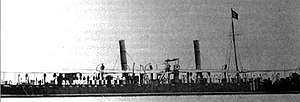Italian cruiser Pietro Micca
Pietro Micca was the first torpedo cruiser built by the Italian Regia Marina, and one of the first vessels of the type to built by any navy. She was laid down in February 1875, launched in August 1876, and completed in July 1877. Armed with a single 16-inch (406 mm) torpedo tube, she proved to be unable to reach the projected speed of 17 knots (31 km/h; 20 mph), and so she did not see much active service. She remained in the Regia Marina's inventory until 1893, but spent most of her 16-year life in the reserve.
 | |
| History | |
|---|---|
| Name: | Pietro Micca |
| Namesake: | Pietro Micca |
| Laid down: | 15 February 1875 |
| Launched: | 1 August 1875 |
| Completed: | 3 July 1877 |
| Stricken: | 7 November 1893 |
| Fate: | Sold for scrap |
| General characteristics | |
| Type: | Torpedo cruiser |
| Displacement: | 598 long tons (608 t) |
| Length: | 61.87 m (203.0 ft) |
| Beam: | 5.97 m (19.6 ft) |
| Draft: | 3.62 m (11.9 ft) |
| Installed power: |
|
| Propulsion: | 1 single-expansion steam engine |
| Speed: | 12.88 kn (23.85 km/h; 14.82 mph) |
| Complement: | 73 |
| Armament: |
|
| Armor: | Deck: .5 to .75 in (13 to 19 mm) |
Design
Admiral Simone Antonio Saint-Bon, then the Italian Minister of the Navy, ordered a small, fast vessel that was armed with torpedoes. Saint-Bon's request came in part due to budgetary problems that prevented building a large fleet of ironclad battleships. Engineering Inspector Felice Mattei prepared the design for the new ship, which became Pietro Micca, one of the first torpedo cruisers, along with the German Zieten.[1][2]
Characteristics
Pietro Micca was 61.87 meters (203.0 ft) long between perpendiculars and had a beam of 5.97 m (19.6 ft) and an average draft of 3.62 m (11.9 ft). She displaced 526.5 long tons (534.9 t) normally and 598 long tons (608 t) at full load.[1] The ship had an iron-built hull with a flat bottom. Much of the ship's internal space was reserved for propulsion system and coal storage, with only the forward quarter reserved for crew spaces and stores.[3] The ship had a very minimalist superstructure, with a small conning tower and a single pole mast. She had a crew of 73 officers and men.[1]
Her propulsion system consisted of one single-expansion steam engine that drove a single screw propeller.[1] Steam was supplied by four coal-fired boilers that were trunked into two funnels. The boilers were separated into two boiler rooms.[3] Though she was designed to steam at 17 knots (31 km/h; 20 mph), with a maximum speed of 20 knots (37 km/h; 23 mph), her hull shape prevented her from reaching either speed. Pietro Micca could only steam at a top speed of 12.88 knots (23.85 km/h; 14.82 mph) from 571 indicated horsepower (426 kW).[1]
The primary armament for Pietro Micca was a single 16 in (406 mm) torpedo tube.[1] The tube was mounted in the bow, above the waterline. She carried ten Whitehead torpedoes. She also carried a pair of machine guns. The ship was protected with an armored deck that varied in thickness from .5 to .75 in (13 to 19 mm);[1] the deck was 7 ft (2.1 m) wide on the flat, and then sloped down to the sides of the hull. It was placed 10 inches below the waterline.[3]
Service history
Pietro Micca was built by the Venetian Arsenal. Her keel was laid down on 15 February 1875, and her completed hull was launched on 1 August 1876. Fitting-out work was finished on 3 July 1877. Shortly after completing sea trials, during which the crew discovered that her hull shape prevented her from reaching her intended speed, Pietro Micca was placed in reserve.[1] Since her low speed prevented her from catching the ironclad battleships she had been intended to destroy,[4] she did not see much service with the Italian fleet.[1] In 1893, she was laid up in La Spezia, along with several other torpedo cruisers of the Goito and Partenope classes.[5] According to Conway's All the World's Fighting Ships, the Italian Navy had informally removed Pietro Micca from the naval register "some years before" formally striking her in 1893. Pietro Micca was sold for scrap on 7 November that year and subsequently broken up.[1]
Notes
- Gardiner, p. 346
- Osborne, p. 36
- Brassey, p. 159
- Osborne, p. 37
- "Naval and Military Notes – Italy", p. 567
References
- Brassey, Thomas A. (2010) [1882]. The British Navy: Its Strength, Resources, and Administration. Cambridge: Cambridge University Press. ISBN 9780511790195.
- Gardiner, Robert, ed. (1979). Conway's All the World's Fighting Ships: 1860–1905. London: Conway Maritime Press. ISBN 0-85177-133-5.
- "Naval and Military Notes – Italy". Journal of the Royal United Service Institution. London: J. J. Keliher. XXXVII: 566–568. 1893. OCLC 8007941.
- Osborne, Eric W. (2004). Cruisers and Battle Cruisers: An Illustrated History of Their Impact. Santa Barbara: ABC-CLIO. ISBN 9781280711367.